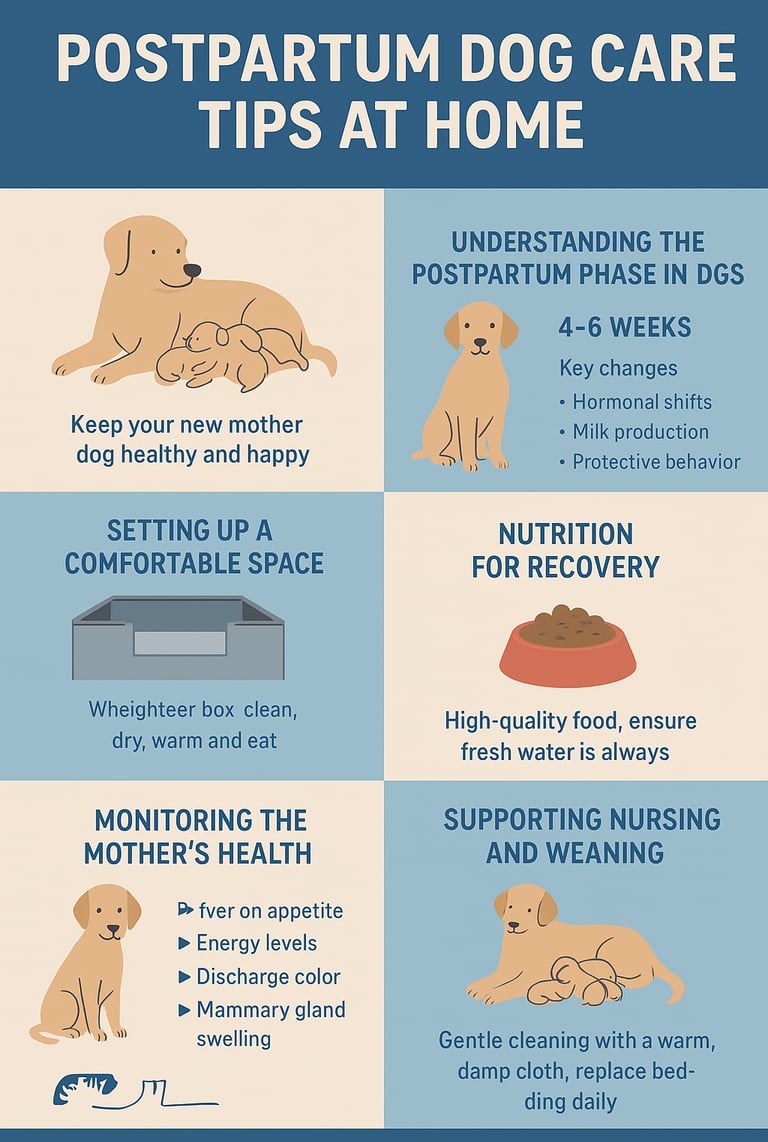Postpartum Dog Care Tips at Home: Keep Your New Pet Mom Healthy & Happy
Easy postpartum dog care tips at home to help your mother dog recover, nurse puppies, and stay healthy after giving birth.
DOG BLOG
admin
9/18/20252 min read


1. Introduction
When your dog becomes a new mom, her body goes through huge changes—both physical and emotional. The postpartum period (also called the whelping recovery phase) is a critical time for her health and for the puppies’ development. Providing proper at-home care can make all the difference in ensuring she recovers well, produces enough milk, and feels comfortable while caring for her litter.
In this guide, you’ll learn simple but effective postpartum dog care tips at home, covering everything from nutrition and hygiene to emotional support and when to seek veterinary help.
2. Understanding the Postpartum Phase in Dogs
Postpartum in dogs generally lasts 4-6 weeks after giving birth. During this time:
Hormonal changes help produce milk and trigger maternal instincts.
Energy demands are high as she nurses puppies every few hours.
Protective behavior may increase, so she might be cautious around strangers.
Warning signs to watch for:
Loss of appetite
Persistent fever
Foul-smelling vaginal discharge
Unusual lethargy
If you notice any of these, contact a vet immediately.
3. Setting Up a Comfortable Recovery Space
Your mother dog needs a peaceful, secure area to rest and nurse her puppies.
Key tips:
Whelping box: Keep it clean, dry, and big enough for her to stretch out.
Temperature control: Maintain 75–80°F for newborn puppies; slightly cooler for the mother to avoid overheating.
Privacy: Limit visitors and noisy environments to reduce stress, especially in the first two weeks.
4. Nutrition for Recovery
After birth, your dog’s nutritional needs increase dramatically.
Feeding tips:
Offer high-quality puppy food or a lactation-specific diet—it’s richer in calories and protein.
Ensure fresh water is available at all times to maintain milk supply.
Ask your vet about supplements like calcium (to prevent eclampsia) and omega-3 fatty acids for better milk quality.
5. Monitoring the Mother’s Health
Daily health checks will help you catch issues early:
Watch for red, swollen, or painful mammary glands—signs of mastitis.
Monitor her energy levels and appetite.
Check for parasites—safe deworming and flea control options are available for nursing dogs.
6. Supporting Nursing and Weaning
First 3 weeks: Puppies nurse every 2-3 hours. Ensure Mom is comfortable during feedings.
Weaning: Start introducing softened puppy food around 3–4 weeks, gradually reducing nursing sessions.
Let her take short breaks away from the puppies to rest and recharge.
7. Hygiene and Grooming
Cleanliness is key to preventing infections:
Wipe her belly, hindquarters, and tail area daily with a warm, damp cloth.
Change bedding every day.
Lightly brush her coat to remove loose fur and keep her comfortable.
8. When to Call the Vet
Immediate veterinary attention is needed if you see:
Persistent high fever
Heavy bleeding
Puppies failing to gain weight
Bad-smelling discharge after the first week
9. Emotional Support
The postpartum period can be stressful for new dog moms:
Keep interactions calm and gentle.
Give her quiet moments without the puppies for mental rest.
Offer praise and affection to strengthen your bond.
10. Conclusion
Caring for your dog after she gives birth is about more than just feeding her—it’s about creating a safe, clean, and supportive environment where both she and her puppies can thrive. With the right attention to nutrition, hygiene, and emotional comfort, your mother dog will recover faster and raise healthy, happy pups.


Address
53 J Avenue, Global City
Yazoo Park - 401 303
Contacts
+91 8082066870
info@dogduedate.com
